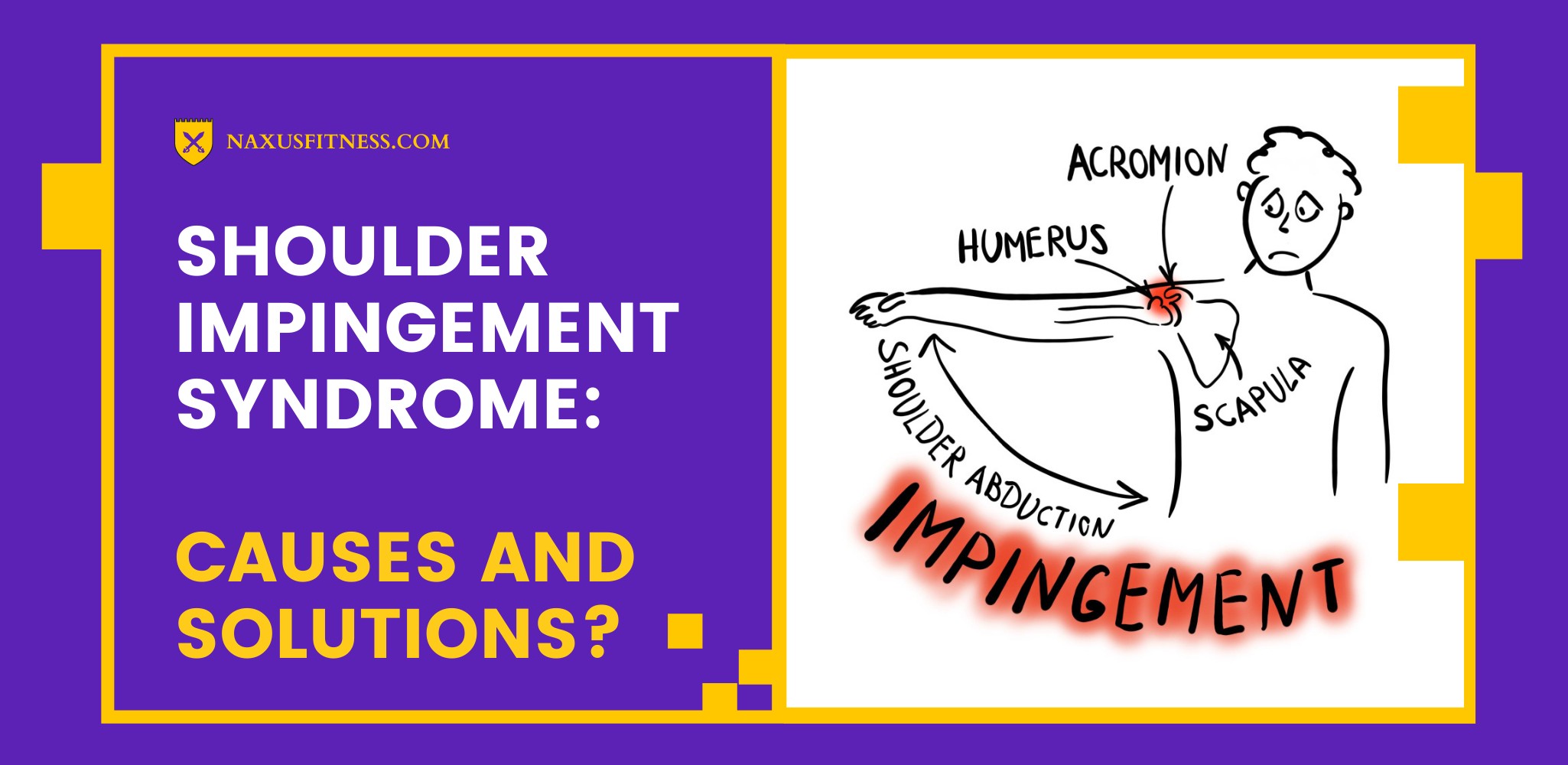Shoulder Impingement: Causes and Solutions
Shoulder Impingement syndrome: How to handle it?
Joints perform the most work during a person’s lifetime. They are twisted, stretched, and sometimes have to carry heavy loads. It’s no surprise they are among the human body parts that cause pain. The so-called impingement syndrome is one of the most unpleasant joint diseases. What is behind this problem? Which joints can be affected? What is the best way to treat it? Having a healthy shoulder is not an easy chore.
Contents
Impingement syndrome: Especially the shoulder is affected
An impingement syndrome occurs when the tendons of the rotator cuff of the shoulder are pinched as they pass between top of upper arm (humerus) and tip of shoulder (acromion). A rotator cuff consists of four muscles and bones connected by a tendon.
The space in the joint in question becomes so small that tendons are constricted. The movement of a joint therefore no longer works smoothly, in the truest sense of the word, but is characterized by pain caused by a collision of the internal parts of the joint.
Any joint may be affected by impingement syndrome. In reality, however, either the hip or shoulder joint is usually affected. Since most impingement syndrome diseases occur at the shoulder joint, we will discuss the hip joint only briefly. In the beginning, the patient experiences pain only sporadically and perceives it as a groin problem. Moving, however, causes the pain to become stronger and to radiate into the thigh. As the affected person turns their angled leg inward, the pain usually intensifies.
The sore point of the shoulder: The supraspinatus tendon
Among the various bones are the collarbone and the humeral bone. Additionally, there are also so-called soft tissues, including muscles, tendons, ligaments, cartilage and bursae. Its rear side is covered by a rotator cuff, which forms a roof over the shoulder joint. There are four muscles in the rotator cuff. The tendons connecting these muscles to the elbow “dock” at the shoulder blades.
It is exactly at this point that impingement syndrome is most likely to develop. Subacromial tendons, including the supraspinatus, can be found close to the head of the acromion. The painful syndrome slowly develops when it becomes constricted. Often, sufferers have an improperly shaped bone or a bone spur in the shoulder area. Due to the sparse protection of the soft tissues of the shoulder joint, this is even more dangerous. A hip joint, for example, has a greater amount of bony tissue to protect its tendons and muscles.
The shoulder joint is one of the most mobile of our body. Fortunately, because without it we would be denied many activities. Have you ever thought about cleaning the house without the shoulder joint, lifting weights or changing clothes after sports? Because the shoulder joint enjoys so mobile and comparatively little protection, it is also quite susceptible to injury. This ranges from the simple “Oops, wrongly moved” to dislocation of the shoulder.
How does impingement syndrome of the shoulder develop?
Impingement syndrome can develop in a variety of ways. There are rare cases in which the parts of the affected joint rub against each other inside due to a narrow gap. Additionally, lime fragments are deposited in tendons and accumulate over time. It is unfortunate that the most common cause is also the most insidious.
Pain does not occur suddenly, but results from years of overload. Tennis players, handball players, and swimmers may suffer from an impingement syndrome. Impingement syndrome is specifically associated with overhead movements. Also affected are painters and mechanics who use their tools with their hands stretched upwards.
Overhead movements as a cause of shoulder impingement
Pain is particularly severe when the arms are raised laterally for those affected. In this posture, the space below the shoulder ceiling is the smallest. As a result, tendons, ligaments, bones & Co. have to divide very little space among themselves at this moment and “squeeze” together like Japanese after work on the train.
Impingement syndrome may also result from bursitis. In addition to swelling, the bursa narrows the joint space. Impingement syndrome continues to affect the tendon if not recognized. It continues to rub against the acromion. As a result, the affected individual feels pain even when he or she is not moving.
During the night, the shoulder pain occurs, for example. As a result of not receiving treatment, people begin to move their shoulders less and less. It can even lead to a so-called frozen shoulder.
To which doctor should you go if impingement syndrome is suspected?
If you suspect that you are developing impingement syndrome, you should see a specialist in trauma surgery and orthopedics.
Having your primary care physician as your first port of call is highly recommended by many people. However, this doctor does not necessarily have the equipment required to conduct a thorough shoulder examination.
The doctor will first ask you questions about your medical history and the nature of your pain. The following questions are typical:
- To what extent do you feel limited at the shoulder joint?
- Does the pain get worse at night?
- Does the pain increase when you lie on one side of your body?
- Is it a dull ache?
- Was there a severe physical strain or injury when the pain started?
- What is your occupation?
- Do you exercise regularly, and if so, what kind?
The doctor will then start checking your mobility after the questioning has been completed. Among other things, he will ask you to put your arms and legs in certain positions (raise your arms, bend and tilt your legs sideways, etc.). Strength is measured by moving your arms and legs against resistance during your examination.
Imaging procedures for examining the shoulder
There are basically three procedures for examining the shoulder joint in more detail using electronic or imaging techniques.
Ultrasound examination (sonography)
As a relatively uncomplicated and inexpensive method of examination, sonography is popular with medical professionals. Sonography can detect muscular thinning and show fluid accumulation in the bursa. The disadvantage here, however, is that the bone tissue is only inadequately visualized. Therefore, sonography alone cannot determine whether an impingement syndrome is present.
X-ray examination
Medical professionals use X-rays first when performing a thorough review of the shoulder because they are inexpensive and easy to obtain. By using X-rays, one can see and detect changes in the bone structure quite precisely.
Magnetic resonance imaging
The most complex, but probably the most detailed exam method is magnetic resonance imaging. In addition to soft tissues, it shows cartilage and bulges on the bones. MRI is essential when a surgical procedure is required. The doctor can plan exactly how to proceed with the operation with the clear graphic representation.
Arthroscopy (arthroscopy)
Arthroscopy is a hybrid form of examination and surgery. With minimal incisions, doctors insert arthroscopes into the joints so they can see the inside via a monitor. Doctors can often treat joint damage as soon as they notice it. This is a great advantage. To do this, he inserts cutters, knives or scissors, depending on the type of damage. He can then use these to remove inflamed tissue or sew torn tendons back together.
Treatment and therapy
It goes without saying that, in general, the earlier you begin treatment, the better chance you have of curing the condition. Of course, the type of treatment depends on how far the degeneration of the shoulder has already progressed. It is vital to find a balance between phases of growth and regeneration.
As already mentioned, there is no “blanket” treatment method for impingement syndrome, as each disease has different prerequisites. Your doctor will be best able to assess how to proceed after the exam to get your shoulder problems under control.
In most cases, non-steroidal anti-inflammatory drugs, such as ibuprofen and diclofenac, are the basis. They inhibit pain and inflammatory reactions. It is recommended because they are easy to swallow and have only minor side effects. Additionally, cortisone injections can be used to treat inflammation. Several injections may be prescribed over a period of a few days/weeks by your doctor. It is not recommended to use cortisone injections in the long term due to its side effects.
Physiotherapy: Strengthens muscle groups, inhibits inflammation
Impingement syndrome can be managed very well using physiotherapeutic exercises. Ideally, the exercises not only strengthen the muscles, but also prevent the syndrome from progressing. Activating certain muscles reduces the tightness under the shoulder canopy and the high position of the humeral head. Therefore, the pressure that otherwise weighs on the tissue repeatedly is reduced, which in turn reduces inflammation.
When you build muscles on the rotator cuff (the muscles “covering” from behind the shoulder blade), the stability and position of the shoulder joint generally improves. Physiotherapy exercises should be carried out conscientiously at all times. By performing these incorrectly, one achieves the opposite of the intended result – namely that the space at the shoulder joint becomes even smaller. Thus, the exercises should be learned or performed under the guidance of a qualified physiotherapist. If you have internalized the exercises after a certain learning phase, you can usually do them alone at home.
Additional pain relief: Cryotherapy and shockwave therapy
Additionally, although certain methods cannot correct the actual malpositions or constrictions, they can alleviate the pain. A key part of Cryotherapy is to use compresses and baths.
The term cryotherapy, or cryogenic therapy, includes any form of treatment that utilizes freezing or near-freezing temperatures. The application of liquid nitrogen can be used to destroy abnormal cells (such as tumors or cancerous cells) through cryosurgery, or cryoablation. Cryotherapy on a small scale can take the form of ice bath immersion or cryotherapy facials.
A cryo chamber is used for either standing or sitting in whole-body cryotherapy (WBC). People will be exposed to liquid nitrogen in subzero temperatures, typically -100 to -140 degrees Celsius, during this process. The chamber requires minimal clothing, consisting only of socks, gloves, suitable underwear, and possible a protective headband and mask.
Additionally, shockwave therapy is another treatment option for impingement syndrome. This is actually used for kidney disease to break up calcified kidney stones so they can be eliminated without surgery. To treat the shoulder using shock wave therapy, the shoulder area is first locally numbed. Shock waves are then focused on the inflamed spot. The calcified tissue is softened and broken down by this process. However, in order to achieve this, shock wave therapy must be repeated several times and at regular intervals. It is ideal for this to reduce the pain to the extent that the body can perform advanced exercises as part of physiotherapy.





